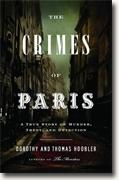The Crimes of Paris
Dorothy and Thomas Hoobler
book reviews:
· general fiction
· chick lit/romance
· sci-fi/fantasy
· graphic novels
· nonfiction
· audio books
· author interviews
· children's books @
curledupkids.com
· DVD reviews @
curledupdvd.com
newsletter
win books
buy online
links
home
for authors
& publishers
for reviewers

 |
The Crimes of Paris: A True Story of Murder, Theft, and Detection Dorothy and Thomas Hoobler Little, Brown Hardcover 384 pages April 2009 |
|
This book will take you on a dizzying, at times stomach-churning tour of “The City of Light” during a fascinating period of its history when, faced with growing crime and daunting new modes of same, French law enforcement labored to develop new, more scientific methods of identifying criminals. It centers on the early years of the new 20th century and the intriguing mystery surrounding the 1911 theft from the Louvre of Leonardo da Vinci’s Mona Lisa. Yet its content broadens out to become a sort of assemblage, taking in art history, Gallic history, detectives (both real and fictional), and new-century science and invention to aid crime detection.
Pity the city’s law-enforcement leadership and gendarmerie in the second decade of the promising new century as they struggled to solve the Mona Lisa snatching while considerably less rarified forms of crime grew in number and category. Some offenses had never before challenged them. Readers who relish tales of audacious thieves will be rewarded. Qualifying as “most brazen” is surely the one who, in 1911, casually lifted Mona Lisa off the wall of the Louvre and disappeared with it for more than two years. The deed seemed to stun all France. Upon its recovery, “more than 100,000 people filed past” in a two-day period, “welcoming back one of Paris’ icons.” As contrast, there’s a touch of the picaresque in accounts of gangs who pioneered auto theft and car hijackings, resulting in a new spectacle: hair-raising chases through Paris streets and suburbs to elude frustrated gendarmes. The latter form of light-fingeredness occurred, mind you, at a time when even the sight of a horseless carriage was still rare. “It seems almost impossible now, since almost everyone has seen car chases on film countless times, but no one had yet conceived the idea of escaping a robbery via automobile.” Criminals of the era also perpetrated murders most gruesome, and certain trials became magnets to the public - “The courtrooms were packed with spectators when the juicy trials of famous criminals were on the docket” - just as super-notorious trials are crowd-pleasers in the U.S. (Luckily, public guillotining never caught on here!) The literary icon Marcel Proust was reported to be an attendee at one sensational trial, and his presence there is said to have “astonished his friends.” Paris had earned the flattering appellation Ville Lumiere - The City of Light - when the 1900 Exposition dazzled some 50 million attendees with its spectacular application of a modern mode of illumination: “Every evening, with a flick of a switch in the Palace of Electricity, light from fifty-seven hundred incandescent bulbs flooded the pavilions.” In addition, it “powered a train that circled the fair... and a giant Ferris wheel, carrying 40 cars and 2400 people at full capacity.” Still, even the brightest and cleanest of light sources newly utilized in ways both practical and eye-popping could not banish the city’s shadows cast by burgeoning criminal acts and their perpetrators. The French, however, are perhaps more sanguine about life’s seamier aspects. Could the “dark side of humanity” have truly demoralized citizens whose literary tradition includes such authors as the Marquis de Sade, Arthur Rimbaud, and Charles Baudelaire - and the not-for-the-squeamish offerings at the Theatre du Grand-Guignol? Originally published on Curled Up With A Good Book at www.curledup.com. © Norma J. Shattuck, 2009 |
|
|
|
 Click here to learn more about this month's sponsor! |
|
| fiction · sf/f · comic books · nonfiction · audio newsletter · free book contest · buy books online review index · links · · authors & publishers reviewers |
|
| site by ELBO Computing Resources, Inc. | |
 There are abundant references to artists of the time; thus, it serves as something of an easily absorbed tutorial about a key period in art. We learn, for instance, that a 19-year-old Spanish lad named Pablo Ruiz visited the 1900 Paris Exposition and was “entranced with the city” to the extent of adopting a new identity – “his mother’s family name: Picasso.” Among artists then in Paris were Henri Matisse and Paul Cezanne.
There are abundant references to artists of the time; thus, it serves as something of an easily absorbed tutorial about a key period in art. We learn, for instance, that a 19-year-old Spanish lad named Pablo Ruiz visited the 1900 Paris Exposition and was “entranced with the city” to the extent of adopting a new identity – “his mother’s family name: Picasso.” Among artists then in Paris were Henri Matisse and Paul Cezanne.